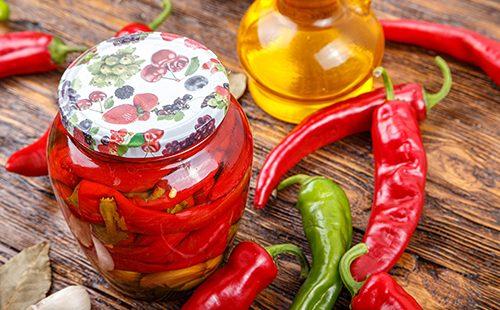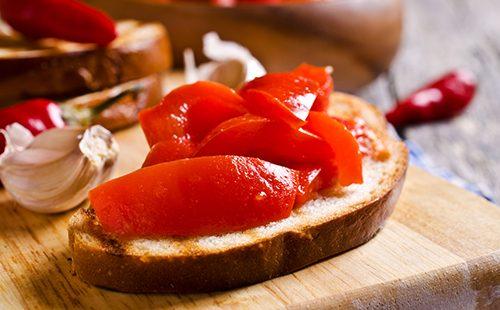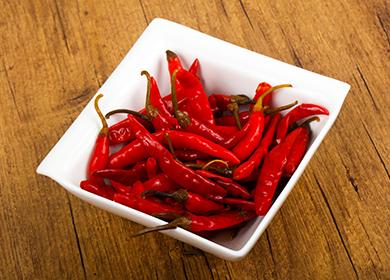Capsicin contained in the composition of the fruit gives the sharpness of bitter pepper; in different varieties of chili, the concentration of this alkaloid is different. At the beginning of the 20th century, the American chemist Wilbur Scoville proposed a scale that determines the degree of severity of each variety of hot pepper.
The choice of the main ingredient
When choosing a chili, pay attention to the appearance of the fruit: the skin should be smooth and elastic, without damage. If there are orange spots on the surface of the pod, the pepper is hit by bugs. When bent, the fetus should bend, not break.
There are many varieties of chili, each of which differs in intensity of taste, color and shape. The table below reveals the features of the most popular varieties.
Table - Varieties of Chili
| Grade | Description |
|---|---|
| Bird's eye | - Saturated red or orange; - elongated, pointed; - very sharp; - common in Mexican cuisine |
| Habanero | - Red, yellow, orange, green; - fleshy; - rounded; - the sharpest of all varieties; - the main ingredient of Tabasco sauce |
| Jalapeno | - Green, as it ripens, turns red; - moderately sharp; - common in Mexico |
| Anaheim | - Dark red; - oblong or round; - mild taste and aroma; - part of curry; - in harmony with rice and legumes, vegetables and meat; - popular in the USA |
| Blanched | - green; - rounded, large; - medium severity; - served with baked dishes and smoked meats |
| Serrano | - Dark red, dark green; - bullet-shaped; - medium hotness; - added to sauces |
Technology
Most often, chili is canned marinade, which includes: water, refined vegetable oil (odorless), 9% vinegar, sugar and salt. Sometimes a component is not added.
Peppers can be poured with cold (cold method) or hot (hot method) marinade. The latter method is the most common, since most recipes based on it are implemented without sterilization: heat treatment and vinegar avoid the need for additional heating.
Sometimes preforms require sterilization in a steam bath. The process is carried out in four stages.
- "Bath". Cover the bottom of a large pan with a towel or a piece of thick cloth.
- Immersion. Put jars with blanks in the vessel, covering, but not closing them with lids. Pour water into the pan so that it hides the containers with preservation “on the shoulders”.
- Boiling. Boil water, reduce heat to prevent violent seething, and detect time. 0.5 l cans are sterilized for 10-15 minutes, 1 l - 25-30 minutes, 2-3 l - 35-40 minutes.
- Warming. Turn the containers with blanks upside down, put them on a pallet and wrap them with a blanket until they finally cool down, for about a day. After that, they can be removed for permanent storage.
The rules of "burning" conservation
The marinade removes part of the sharpness of the chili, however, the workpiece is sharp. If the pepper is preserved in its pure form, it is advisable to use less burning varieties, if with other vegetables, more “burning” varieties are also suitable. Here are four more points that will tell you how to pickle hot pepper for the winter.
- Prepare the cans. Wash storage containers with laundry soap or soda and sterilize in a steam bath, in the oven or in a slow cooker.
- Choose the right caps. Use only metal: screw or sealing. Boil for five to ten minutes or scald with boiling water.
- Clean product. Before cooking, rinse the pepper and soda in running water.
- Cut the peppercorn. Often, the whole chili is preserved, in this case it is necessary to cut the dry stalks, but leave a small “tail”. You can also clear the pod from seeds without cutting, chop the fruit with rings, straws, or grind it with a meat grinder.
Pickled hot peppers for the winter: 9 recipes
You need to work with hot pepper in rubber gloves to protect the skin from burns. Do not touch the face and eyes; seal open skin lesions with a band-aid. After cooking, wash your hands thoroughly with soap and water.
Base
Features. The simplest recipe for pickled hot peppers involves the use of a small amount of products and is implemented very quickly.
Necessary components:
- hot pepper - 200 g;
- water - 1 l;
- garlic - two to three cloves;
- vinegar - three tablespoons;
- sugar - two tablespoons;
- salt - a tablespoon;
- parsley - two or three branches;
- laurel - one or two leaves;
- allspice - three to four peas.
Step by step
- Remove the stem from the pepper.
- Fill the cloves of garlic (whole), peas of pepper, parsley (without cutting) and laurel into jars.
- Fill the container with the main component, trying not to leave voids.
- Boil water, add vinegar, sugar and salt, keep on moderate heat for two to three minutes.
- Pour hot marinade into a container with prepared foods, roll up.

Fast
Features. Instant snacks, preserved according to the described recipe, can only be stored in the refrigerator. You can close the workpiece with plastic covers. If you take peppers of different colors, the appearance of conservation will turn out to be incredibly spectacular.
Necessary components:
- chili - 1 kg;
- wine or apple vinegar - half a glass;
- salt - a tablespoon.
Step by step
- With pepper cut the stem and get the seeds.
- Process the fruit with a meat grinder using a large-mesh lattice.
- Stir the twisted product with salt and vinegar, put in jars to the brim. Close or roll up.
With tomatoes
Features. The specificity of the method in the preliminary frying of vegetables, for this it is desirable to use a cauldron or a thick-walled pan. Tomatoes choose dense, plum-like: they hold their shape better.
Necessary components:
- hot green pepper and carrot - 1 kg each;
- tomatoes - 0.5 kg;
- garlic - one or two heads;
- vinegar - a glass;
- vegetable oil - half a glass;
- sugar - two tablespoons;
- salt - half a tablespoon;
- basil, tarragon, oregano to taste.
Step by step
- Pour oil into a cauldron and fry carrots cut in circles 3-5 mm thick.
- When the vegetable softens, introduce chopped garlic, pepper without stalks, fry for five minutes.
- Stir in chopped tomatoes, spices, sugar and salt, and simmer for another five minutes.
- Pour vinegar, remove from the stove.
- Not allowing the workpiece to cool, distribute the mass in banks, roll up.
With tomato juice
Features. Another option of "chili in tomato" involves the use of juice squeezed from fresh tomatoes as a fill. You can do this using a juicer or scroll the fruits with a meat grinder and squeeze the juice with gauze.
Necessary components:
- tomato juice - 2.5 l;
- hot pepper - 1 kg;
- vegetable oil - one and a half cups;
- sugar - 90 g;
- salt - 30 g;
- chopped garlic - a tablespoon;
- vinegar - a tablespoon;
- ground black pepper - a quarter of a teaspoon;
- laurel - five sheets.
Step by step
- Stir sugar, salt, laurel, black pepper, oil in the juice. Boil, stand on low heat for 20 minutes.
- Introduce vinegar and garlic, heat for another two to three minutes.
- Put pepper in jars and pour the fruits in boiling sauce, roll up.
With honey
Features. Chili in honey filling is usually served with meat dishes, it is recommended to use red pods for preservation.
Necessary components:
- hot pepper - 450-500 g;
- water - 0.5 l;
- honey - 100 g;
- vinegar - 50 ml;
- garlic - four cloves;
- salt - 25 g;
- mustard seeds - a teaspoon;
- laurel - two leaves;
- black pepper - six peas;
- allspice - four peas.
Step by step
- Put laurel and peppercorns, whole cloves of garlic and pepper pods with a cut stalk in a jar.
- Pour boiling water into the container, cover and stand for a quarter of an hour. Drain the liquid.
- Pour salt, mustard, vinegar, honey into a saucepan, stir and pour cold water, boil, keep on low heat for no more than one or two minutes.
- Pour the hot marinade into the jar with the workpiece, roll it up.
With onion
Features. Hot peppers marinated in cold vinegar can be preserved with onions. It is advisable to use the fruits of salad varieties with a sweet, mild taste.
Necessary components:
- pepper - 20 pods;
- onions - ten medium-sized heads;
- garlic - one head;
- vinegar 6% - two glasses;
- sugar and salt - two tablespoons each;
- laurel - one leaf.
Step by step
- Peel the seeds and chop them into rings, onions in half rings, garlic in small cubes.
- Mix the mixture and put in jars.
- In vinegar, dilute sugar, salt, crushed laurel.
- Bring to a boil, stirring, remove from heat. Wait for the marinade to cool completely.
- Pour the filling in the banks, roll up. Store in a cool place.
In Armenian
Features. Such preservation is called “Tsitsak” - this is one of the national dishes of Armenian cuisine. In honor of the snack, a variety of hot pepper was named, which experts consider the best for this spin. Long green pods are good here, not too sharp in taste. In fact, such pepper is not pickled, but pickled, since there is no vinegar in the traditional recipe. Salt hot pepper in Armenian for the winter can be in an enameled pan or in jars.
Necessary components:
- hot pepper - 2 kg;
- water - 2-3 l;
- salt - a little more than half a glass;
- garlic - four to five cloves;
- celery - a twig;
- leaves of cherry and horseradish - three to four pieces;
- cilantro seeds - a teaspoon;
- other spices to taste.
Step by step
- Do not wash the pepper, put it in one layer on a table or tray, leave for one to two days.
- Wash the fruits, dry.
- Pierce each pod with a knife or fork: thanks to this, the brine will fall into the fruit, and the pepper will not emerge during the preservation process.
- Stir salt in water.
- In a container for salting, add, alternating with herbs and cloves of garlic, pepper, pour in cold saline.
- Soak under oppression at room temperature for 12 days. When the pods turn yellow, preservation is complete.
In Korean
Features. The components that define the taste base of pepper in Korean are garlic and spicy spices.
Necessary components:
- chili - 1 kg;
- water - 400 ml;
- garlic - half the head;
- vinegar - 70 ml;
- sugar, salt - half a tablespoon;
- ground red pepper, ground black pepper, ground coriander - half a teaspoon.
Step by step
- Put the pepper in jars, trying to leave as few voids as possible.
- Stir in salt and sugar in water, boil.
- Introduce spices and chopped garlic, after boiling again, reduce heat, mix vinegar. Remove from stove.
- Pour the hot "broth" into the jars of pepper, roll up. The appetizer is ready to eat after three days.
In Georgian
Features. Georgian green hot pepper is a spicy, tart appetizer, the taste base of which is celery root.
Necessary components:
- hot green pepper - 2.5 kg;
- white wine vinegar - 0.5 l;
- vegetable oil - a glass;
- garlic - 150 g;
- celery root - 100 g;
- parsley - 50 g;
- sugar or honey - three tablespoons;
- laurel - five sheets;
- salt to taste.
Step by step
- Cut the stem from the pepper.
- Stir in the vinegar oil, add sugar, salt, laurel. Boil over low heat.
- Immerse half the pepper in the marinade, cook for seven to ten minutes, turning the pods from time to time so that they heat up evenly.
- Using a slotted spoon, get the fruits, load the remaining ones, repeat the “procedure”.
- Remove pepper from the marinade, remove the pan from the stove.
- Take the chili out of the bowl.
- Grind parsley, finely chop the garlic and celery, and add spices to the cooled marinade.
- Boil the “broth” again and let it simmer for two to three minutes.
- Pour pepper with marinade and leave for 24 hours in the refrigerator.
- Arrange on banks, pour marinade, sterilize, roll up.

How to make the taste softer
To make pickled hot peppers milder in the winter, you can let the collected pods lie down at room temperature for several days. Here are three more tips from the hostesses “with experience”.
- Fruit selection. Long and thin pods are pickled faster, such fruits are conveniently compactly placed in jars, and they look spectacular.
- Elimination of excessive burning. To remove excessive bitterness, you can soak the fruits for a day in cold water, several times the fluid needs to be changed. Or pour boiling water for ten minutes.
- Void Filling. If there is not enough chilli for a full can, you can fill the voids with chopped strips of bell pepper of different colors.
How to serve
Eating pickled hot chili peppers, you can bite with cheese or bread. It is recommended to add the product to soups and broths, vegetable dishes, baked chicken and meat dishes. The most resourceful housewives are looking for many ways to use preservation to create gastronomic masterpieces, here are three of them.
Pizza
- Stir 50 g of yeast into 250 ml of warm milk.
- Rub two eggs with a pinch of salt and introduce the mixture into the milk-yeast composition.
- Introduce 200 g of flour, four tablespoons of vegetable oil, mix well and add another 200 g of flour.
- Soak the dough for an hour and a half in a warm place.
- Roll out the dough into a layer, 0.5 cm thick, and put on a baking sheet.
- Cut the tomato into thin circles and spread around the entire perimeter of the workpiece.
- Place 250 g of finely chopped salami with the next layer, then 100 g of pickled hot pepper chopped with rings.
- Sprinkle with grated Parmesan.
- Send in an oven preheated to 200 ° C for 20-25 minutes.
Salad
- Cut into slices three or four boiled potatoes, two boiled eggs and two medium-sized tomatoes, chop two pickled cucumbers in circles, two or three pods of pickled pepper in rings.
- Mix one or two tablespoons of mayonnaise and sour cream, a teaspoon of mustard, salt and black pepper to taste. Introduce a bunch of chopped parsley and dill.
- Lay out the bottom of a flat plate with torn lettuce leaves, then lay out in heaps, without mixing, the prepared ingredients.
- Place sauce in the center of the dish.

Sandwiches
- Cut one or two pods of pickled pepper into rings, 300 g of boiled lamb into straws, two pickled cucumbers into circles.
- Lubricate ten slices of wheat bread with a thin layer of butter.
- Distribute lamb, pepper, cucumbers into pieces.
- Sprinkle with grated cheese and microwave for a minute.
- Serve garnished with sprigs of basil.
Pickled hot pepper recipes are easy to execute. At the same time, for winter days, harvesting will be very useful. It is not without reason that in the Caucasus they say that nothing warms the body and soul as hot as a snack.
Other pizza recipes
Sausage pizza topping
Shrimp Pizza
Pizza with mushrooms and sausage
Delicious pizza with a simple recipe

